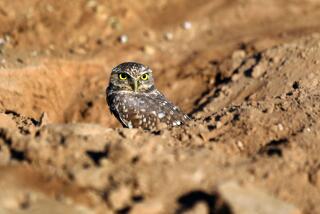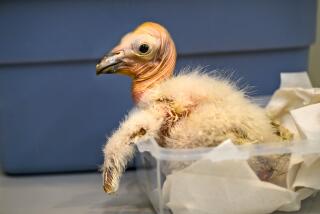BREEDING BIRDS: ORANGE-CROWNED WARBLER : ORANGE-CROWNED WARBLER (Vermivorfa celata Say)
- Share via
Description: Olive above, paler below. Yellow under tail coverts and faint, blurred streaks on sides of breast distinguish this species from the similar Tennessee Warbler. Also, the Orange-crowned warbler has a thinner and slightly down-curved bill and a longer tail.
Habitat: Open, brushy woodlands, forest edges, chaparral and riparian woodlands.
Diet: Berries and plant galls.
Song: A high-pitched staccato trill; call note is a sharp chip .
Nest: Usually hidden on ground or low in shrub or vine; made of coarse grass, bark strips, lined with fine materials.
Eggs: White, marked with reds or brown; mostly at large end.
Natural history notes: These birds are widespread and fairly common in the west, but many details of breeding biology are largely unknown. They can be seen regularly feeding at red-naped sapsucker wells. The tawny-orange crown, absent in some females and juveniles, is seldom discernible in the field. Immature Orange-crowned warblers can be particularly drab in color.
Breeding bird atlas: To report bird breeding activity in your neighborhood, or to get information on the breeding bird atlas (now in its fifth and final year), call Sea and Sage Audubon Society members Sylvia Gallagher, (714) 962-8990, or Nancy Kenyon, (714) 786-3160.
Note: Map is divided into 5-kilometer squares so that Audubon Society volunteers can more easily survey areas on a regular basis.
Sources: Sea and Sage Audubon Society; “The Birder’s Handbook,” Ehrlich, Dobkin and Wheye, Fireside Books (1988); “Field Guide to the Birds of North America,” National Geographic Society (1987); “Birds of Southern California: Status and Distribution,” Garrett and Dunn, Los Angeles Audubon Society (1981).
More to Read
Sign up for The Wild
We’ll help you find the best places to hike, bike and run, as well as the perfect silent spots for meditation and yoga.
You may occasionally receive promotional content from the Los Angeles Times.






